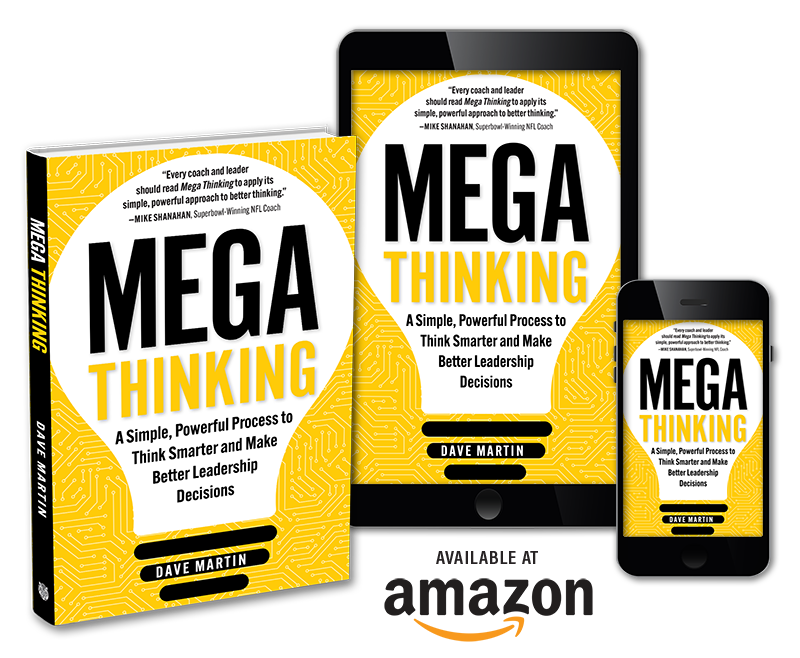As a reminder, Mega Thinking, or great thinking, can be achieved by using a simple, powerful process to make better leadership decisions. This process enables you to define the ten or fewer MegaCepts, or greatest thoughts, on any topic. I deeply believe that the ability to make better personal and professional leadership decisions leads to a more fulfilling and successful life.
This post will focus on our second MegaCept for my book, Mega Thinking: A Simple, Powerful Process to Think Smarter and Make Better Leadership Decisions.
MegaCept #2: How your brain thinks
Scientific research has confirmed that the brain thinks at the subconscious and conscious levels. Mega Thinking presents a process to improve your conscious thinking in general and help you think smarter on more complex, technical, and important topics.
I’ll dive into the 4-step MegaCepts process in future posts. First, though, let’s think a little bit more about thinking itself. Many believe that thinking is the most important activity we can do, with the greatest impact on our lives.
One way to describe the human thinking process is to explain it in the same way experts describe how a computer works. We have seen incredible advances in computing in the last few decades, but despite this computing revolution, the original computing model is still valid. So, as simple as it sounds, it is applicable and enduring. Computers are made up of four basic “parts”:
- Input: This is the raw data that is fed into a computer on a given subject or topic via multiple devices and sources.
- Process/processing: A computer analyzes, processes, and “thinks about” the input by employing powerful software programs that provide the logic for this process. The computer is always “thinking” logically, in a highly organized and structured way!
- Storage/memory: This is where the computer stores temporary (memory) or permanent (storage) answers, analyses, conclusions, and so forth.
- Output: The computer provides output in many forms and at any time it is asked to do so.
Given the incredible impact of the computer and the information revolution, this may seem overly simplistic. But even though it is a simple model, it is also powerful and valid. When you read the Mega Thinking book, you will learn how to apply an analogous model that is simple and powerful for thinking smarter: the MegaCepts process.
The important concept here is that the human brain works in much the same way as the computing model, as shown in the figure.
- Input: This is the “raw” data, facts, and information that is fed into the brain on many different subjects and topics, via multiple sources, including seeing, hearing, smelling, tasting, and touching.
- Process/processing: The brain analyzes, processes, and thinks about the input. Some of this is subconscious, such as when the brain regulates your breathing and heartbeat. Some of it is conscious for simple “processes,” such as showering and getting dressed. And some of it is conscious and involves more sophisticated thinking on more complex subjects, such as the study of physics or how to be a good parent. The brain is always “thinking” logically in a very organized and structured way for subconscious and simple conscious processes and topics. But very often, the brain is not applied to more complex subjects in an organized and structured way. It can use some help here, and that help can come directly from the person who has the brain!
- Storage/memory: This is where you store temporary and permanent answers, analyses, conclusions, facts, and so forth. Your brain has an extremely large storage and memory capacity.
- Output: The brain provides output in many forms and at any time it is asked to do so. Many times, this is done subconsciously, or it is done consciously for simple subjects or processes. Many times, on more complex subjects, the brain simply provides output that was stored in the memory but was not processed or thought about. The key to more intelligent output is to think—really think, in a logical and structured manner—before simply “dumping your memory.”

The human brain and computer both “think” in much the same way!
If applied properly, your brain has thousands of times more processing (thinking) power than a computer. For example, consider that developmental psychologist Howard Gardner identified nine different types of intelligence: verbal, logical, visual, kinesthetic, musical, interpersonal, intrapersonal, naturalist, and existential. We could list many other examples of the brain’s power, but it is sufficient to say that your brain, and its ability to think, is far more sophisticated than the most powerful computers.
However, to achieve the incredible power of thinking that your brain possesses, you need to do the following:
- Commit to thinking versus repeating what you stored away in your memory from the “raw” input you received.
- Apply a disciplined, structured, and organized approach to thinking. Much more on this fascinating topic in future posts.
Thanks again for visiting! If you think my book, Mega Thinking, would have value for you, please visit this website in mid-October 2024—we’ll have a link ready, so you can purchase your copy on Amazon. And independent of your interest in the book I would love to hear from you about your questions and ideas. Contact me at dave@megathinkingbook.com. And let’s have a coach and player chat!
Coach Dave

